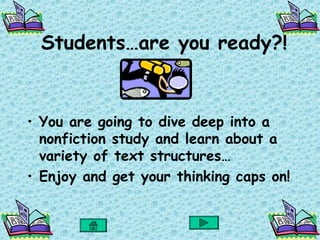
Nonfiction Text Structures
- 1. Students…are you ready?! • You are going to dive deep into a nonfiction study and learn about a variety of text structures… • Enjoy and get your thinking caps on!
- 2. NONFICTION: TEXT STRUCTURES A lesson incorporating •Reading •Writing •Science
- 3. Five Text Structures Go ahead and count them on your hand: • 1. Description • 2. Sequence • 3. Compare and Contrast • 4. Cause and Effect • 5. Problem and Solution
- 4. Features of DESCRIPTION • Main idea • Unique features • Supporting ideas • Examples KEY WORDS to look for: “for example, involves, for instance, next, also, within…”
- 5. Features of SEQUENCE • List in order a series of events • Steps in a process KEY WORDS to look for: “first, second, in addition, then, last, finally, another…”
- 6. Features of COMPARE AND CONTRAST • Lists and explains similarities and differences of two ideas, objects, or processes KEY WORDS to look for: “different from, same as, alike, similar to, unlike, most, while…”
- 7. Features of CAUSE and EFFECT • Explains causes or reasons for an event and the results or effects of this event KEY WORDS to look for: “because, so that, thus, unless, therefore, since, reasons for, then…”
- 8. Features of PROBLEM and SOLUTION • States a problem and possible solutions, or ways the problem can be solved KEY WORDS to look for: “problem is, a solution is, solved by, possible answer, in conclusion…”
- 9. Now let’s see what you have learned… • Sample Sentence: “Golden Eagles are powerful raptors with large brown bodies and small heads with golden crowns.” What type of sentence is this? a. Description b. Problem and Solution c. Sequence
- 10. When reading INFORMATIONAL TEXT: • Reading and writing are important skills in all subject areas, including science • Understanding and using these different text structures will help enhance your reading and writing in nonfiction • Think about how knowing these different text structures will help you read and write a nonfiction science report for our next unit on the Solar System
- 11. • Make sure to pay close attention to the key words in the sentence
- 12. • The correct answer is “description” text structure because the sentence is describing the Golden Eagle in detail.
- 13. How can I apply this in my own learning? • Reading expository • Higher level or informational thinking: texts • Describe • Reader’s responses • Compare • Writing nonfiction • Explain report on _____ • Connect • Science • Social Studies
- 14. Now it’s your turn to apply what you have learned: • Look at the sample sentence strip on the board • What text structure does this sentence fit best? (description, sequence, compare and contrast, cause and effect, problem and solution)
- 15. Sentence Strip Activity • One student will read • One student will the sentence at your share WHY the table aloud sentence fits that • Determine what type text structure of text structure it • One student will is as a team match it correctly on • One student will the board share what type of text it is with the EVERYONE rest of the class PARTICIPATES